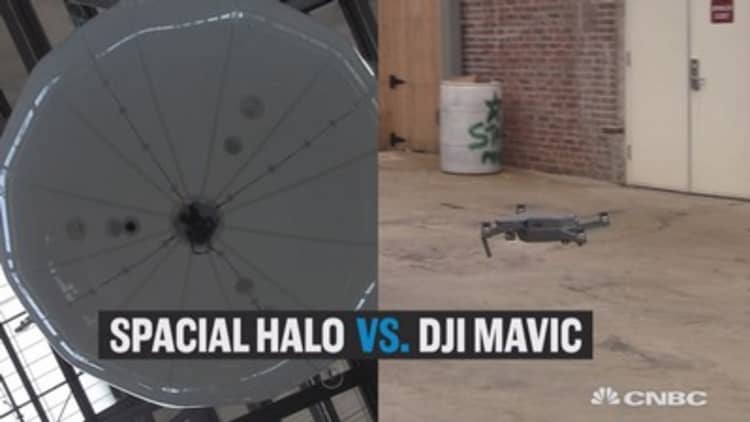
At the Liberty Science Center in New Jersey recently, a casual observer could be forgiven for mistaking the floating object within for a giant onion, or perhaps even a UFO. However, the bulbous device, which bears more than a passing resemblance to a weather balloon, was neither of those things.
It was the Halo, the latest in a generation of drones.
Unlike other unmanned aerial vehicles, however, the
Drones are a new vernacular within the language of cinematography.Michael Chamblissmotion picture and TV specialist
"It's basically a robotic cloud," Alex Chatham, Spacial's co-founder, told CNBC recently, adding that its specifications made it ideal for safely filming sporting events, concerts and ceremonies.
"It's quiet, there's nothing about it that's menacing, there's nothing about it that's jarring or will put you at unease," Chatham said. "We're trying to create a market that doesn't exist now."
In 2015, Chatham, his brother Will, and friend Georgi
Will Chatham, who has worked with major news organizations, major brands and even a few rappers like Jadakiss and ASAP Rocky, described the contraption as "a helium-filled, neutral buoyancy" blimp.
Unlike quadcopters and other conventional drones, the Halo's buoyancy allows the drone to remain floating in the event of a total power loss, bumping harmlessly against walls and people. The drone uses helium for its inert, fireproof and nonreactive properties. This makes it safe to fly indoors, even at a crowded festival.
Flying the Halo is a different experience than with most other drones. The device is decidedly slower (a top speed of 10 mph versus up to 40 mph with conventional units), and its controls can be difficult for those accustomed to propeller-using vehicles to master.
Nevertheless, the Halo is proving to be popular with clients, several of whom have an ulterior motive: using the sphere's white space for advertising. An early prototype was commissioned by the New Jersey Devils NHL team to fly their logo during a game. The flagship iteration of the drone flew stickers promoting March's New York City Drone Film Festival and the Liberty Science Center.
The Spacial team hopes to capitalize on this early interest by featuring flexible screen technologies and even technology that lets the drone glow in the dark.
The floating future of film
The Halo is not the first drone based on a balloon. In 2015, Swiss company
The trend comes as drones are
Television and movie producers, meanwhile, are a big part of that appeal, as the gravity-defying shots drones are able to deliver help craft a more compelling narrative. "Whenever you have a tool at your disposal that allows you to tell the story more efficiently and more poignantly, you use it," Pieter Jan Brugge, executive producer of the Amazon series "Bosch," told The Wall Street Journal in a 2015 interview. "The shot tells the story."
"Drones are a new vernacular within the language of cinematography," said Michael Chambliss, a motion picture and TV specialist with the International Cinematographers Guild.
"Movies in the 1950s had their look, and part of their look was due to the idea that a camera was a 150-pound thing. And all of a sudden when cameras got lighter, we could start doing road movies, all of a sudden concepts like 'Easy Rider' became possible," he added. "The way we move a camera influences how we tell our stories."


